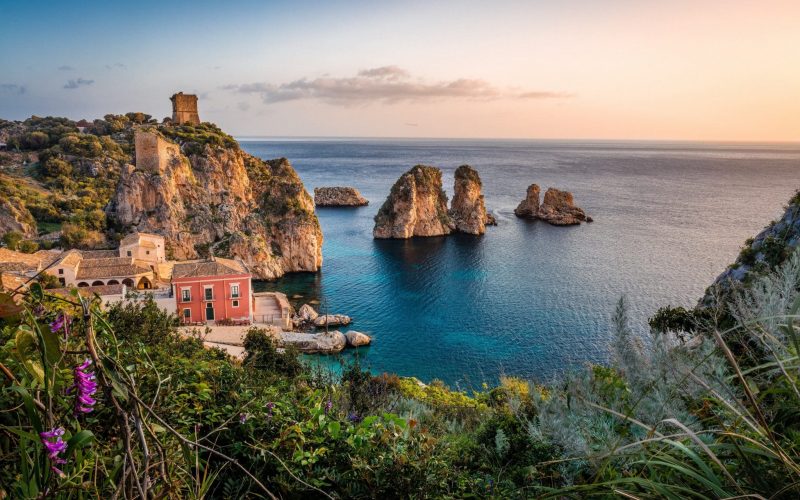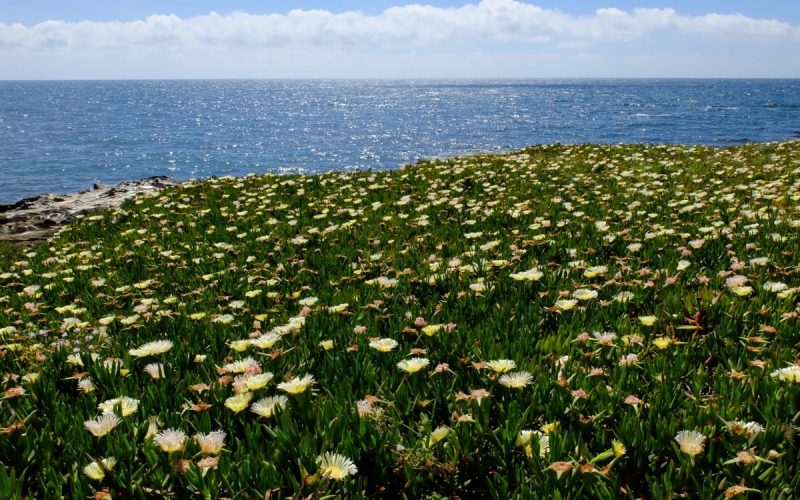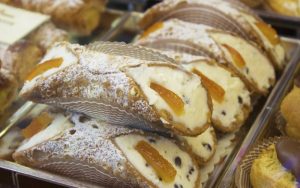Sicilian cooking, at its simplest, is rooted in the principles of the famous Mediterranean diet. The basic ingredients are mainly vegetable (wheat, cereals, beans, vegetables, fruit) and seafood (blue fish, tuna, mollusks and much more). Red meat is a little less common, although it does appear in the form of offal. The salt is mainly marine and used in moderation. Flavorings come chiefly from aromatic herbs like basil, parsley, mint, bay leaf, rosemary, sage and wild fennel, or from the island’s plentiful crops of citrus fruits. The base for stuffings and comfort foods usually features some combination of pine nuts, raisins, toasted breadcrumbs, orange zest and lemon juice. Pistachios are also often used in the preparation of both first courses and desserts (the crop grown in the Bronte area is renowned worldwide and widely exported across Europe) and almonds, which are widely present throughout the island.
True Sicilian cooks and chefs will use only the highest quality extra virgin olive oil, both for cooking and for seasoning. Butter, is rarely used – the occasional substitute for oil is sugna, an animal fat similar to lard (often used for street food).
An important thing to underline is that a Sicilian dining table will be laden with fresh, organic food and that seasonal and local produce is always preferred.
We must discuss street food, of which Palermo is certainly the undisputed capital. If you want a quick, inexpensive and usually hand-held snack the stalls and kiosks of the city’s streets and markets have you amply covered: you can find sandwiches with panelle (chickpea fritters) or spleen (the famous ‘pane ca meusa’), battered vegetables, stigghiole (entrails wrapped around a leek and grilled), arancine and much more. We’ll be honest, we know they don’t always sound the most enticing but they taste delicious! While you are in Palermo, if you’d like to sample an arancina or croquette in slightly calmer surroundings, we recommend the Antica Focacceria San Francesco. For the full sensory experience, head straight to Vucciria or Ballarò, the two most famous and historic markets of the Sicilian capital – by the way, if you are asking yourself if visiting Palermo might be unsafe, here our extensive article about mafia and crime in Sicily.
Sweet tooth? The deserts and sweets of the island deserve their own separate chapter. Often based on seasonal or dried fruit, and almost always tied to religious traditions, Sicilian sweets are very sugary and very indulgent. Ricotta is often used, for example in cassata and cannoli, and often mixed with chocolate and candied fruit. Another great local product is manna, a sugary resin scraped from the bark of the ash trees, mainly produced in the Madonie and exported all over the world. If you want the perfect setting in which to sample it, pay a visit to the Pasticceria Fiasconaro pastry shop in Castelbuono, a town in the Madonie hills outside Cefalù, and try one of their famous panettone with manna cream. Last but not least, in the town of Modica chocolate is still prepared according to the original Aztec recipe which arrived with the Spanish in the 16th century.
And of course, we can’t fail to mention gelato (ice cream) and granita (crushed ice and fruit drink)! They have always been important elements of daily life in Sicily and (if you’re not careful) can even replace an entire meal! A kind of ice cream (called sherbet) was produced here by the Arabs who mixed the snows of Mount Etna with brown sugar and fruit juices. And homemade ice cream as we know it was the creation of the Sicilian Francesco Procopio dei Coltelli in 1600, who invented a sorbet machine that resembled the modern ice cream makers. Not content with changing the food world once, Procopio then moved to Paris and opened the first Café in the city’s history (the Café Procope). Quite the legacy!




 Mamma mia, where do we start!? Thanks to the wide range of cultures that have settled here over the past millennia, Sicily has a rich and varied cuisine that is the envy of the whole world. Even other Italians admit that if you want to eat well, you need to come and visit us here! You can trace the island’s history through our menus, from the seafood and cheese legacy of Magna Grecia, to the sweet treats brought by the Arabs, and into the Jewish roots of Palermo’s meaty street food.
Mamma mia, where do we start!? Thanks to the wide range of cultures that have settled here over the past millennia, Sicily has a rich and varied cuisine that is the envy of the whole world. Even other Italians admit that if you want to eat well, you need to come and visit us here! You can trace the island’s history through our menus, from the seafood and cheese legacy of Magna Grecia, to the sweet treats brought by the Arabs, and into the Jewish roots of Palermo’s meaty street food.